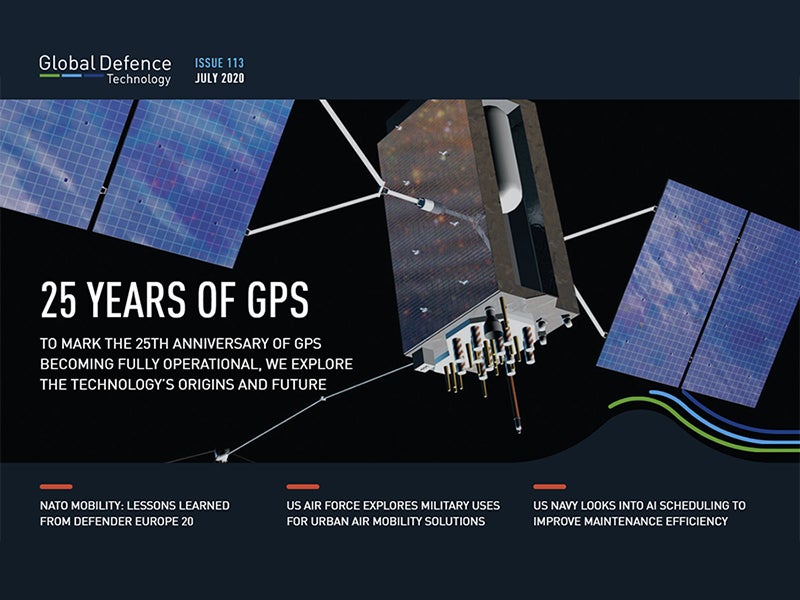
In this edition: 25 years of GPS, DARPA’s new low earth orbit satellites, NATO mobility lessons from Defender Europe 20, the US Air Force’s interest in flying taxis, military uses for tethered drones, what AI-powered scheduling can do for ship maintenance efficiency, and more.
Global Defence Technology is back for another issue packed with industry news and analysis. In this issue, we look back at 25 years of GPS technology, find out why the US Air Force is interested in emerging urban air mobility technologies, ask US Army Europe about the NATO mobility lessons learned during Defender Europe 20, and more.
Whether you are on a desktop, tablet or smartphone, you can read the magazine for free online.
This month marks the 25th anniversary of GPS reaching full operational capability. We mark the occasion with a special feature exploring the history and significance of GPS, as well as ongoing and future developments.
Also in this issue, we speak to DARPA and Lockheed Martin about the first stage of Blackjack, a project developing satellites for the US Department of Defense, and why the programme is moving away from traditional satellites in geosynchronous earth orbit in favour of a constellation of smaller low earth orbit satellites.
A cornerstone of NATO is the ability to get troops from the US to Europe in order to defend its member states, and the infrastructure enabling this was tested during Defender Europe 20 earlier this year. We speak to US Army Europe and the Atlantic Council about the mobility lessons learned from the exercise.
We also find out how the US Air Force is getting on board the urban air mobility revolution with a competition for military ‘flying taxis’, explore the benefits of tethered over wireless UAVs for military applications, and learn how the integration of AI into shipyard operations could help solve maintenance scheduling problems for the US Navy.
In this issue
Happy 25th, GPS
To mark the 25th anniversary of GPS becoming fully operational, we explore the technology’s origins and future.
Read the article.
Project Blackjack takes off
We speak to DARPA and Lockheed Martin about their work on a constellation of low earth orbit satellites. for the US military.Read the article.
Improving NATO mobility in Europe
Defender Europe 20 tested European NATO infrastructure for troop movement. We review the lessons learned from the exercise with US Army Europe and the Atlantic Council.
Read the article.
Flying taxis for the US Air Force
The US Air Force is getting on board the urban air mobility revolution and exploring military uses for flying taxis.
Read the article.
Drones on a wire
As UAVs become more commonplace, we explore tethered options and use cases where they may prove superior.
Read the article.
A stress test for enterprise resource planning
IFS outlines four considerations for aerospace and defence manufacturers as they deal with the economic effects of the pandemic, and explains how they can maintain business agility.
Read the article.
Keeping ships in the water with AI
The US Navy is looking into AI-powered scheduling tools for its shipyards to improve efficiency in ship maintenance.
Read the article.
Next issue preview
In response to the coronavirus pandemic, Farnborough Air Show is going fully digital this year. We speak to the organisers to find out what it takes to bring an air show online, and round up some of the highlights from the new-format event.
In 2021, the Royal Navy’s Project Selborne will kick off a major contract to bring together all aspects of navy training. We speak to a consortium of Elbit, Raytheon, Capita and Fujitsu to get the inside track on their bid.
University of Missouri engineers have designed a flexible material that can help buildings withstand multiple earthquakes. We find out about its potential for military applications, such as protecting against vibration in mechanical parts and new capabilities in soldier protection and manoeuvring.
Also in the next issue, we take a look at drone maker Parrot’s mission to move into defence markets, hear from QinetiQ about the development of digital test and evaluation systems for military equipment, and speak to Digital Concepts Engineering about its involvement in the Army Warfighting Experiment.
Subscribe to be notified when the next issue of GDT is available.
Visit our archive to read past issues for free.



